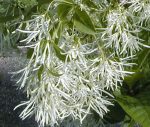
This native of woodland edges, stream banks, and roadsides from Massachusetts, Kentucky, and Missouri south to Florida and west to Texas, is a small deciduous shrub or tree with a spectacular bloom in late spring. Growing 12-35 feet tall, usually 20 feet, the fringetree may be single or multi-stemmed, and bears masses of fragrant white flowers before or about the same time that the leaves appear. Each flower has 4-6 petals 1 inch long that hang so as to give it the appearance of fringe or beards giving the tree two common names including old man’s beard. Fringetree is usually dioecious (male and female flowers on different trees) with the male flowers being more showy than female. The female flowers, however, give way to blue-black berries that are attractive to birds and other wildlife. The leaves are glossy oval leaves are lanceolate and turn yellow in fall but drop quickly so do not add much to autumn coloration. Easy to grow in sun or partial shade and with no significant pests or diseases, fringetree is an excellent specimen tree, does well in woodland borders especially, and does well in containers. It is tolerant of air pollution but not tolerant of long periods of drought. White fringetree is a member of the olive family, Oleanceae, that also includes lilac, privet, and forsythia. The genus name, Chionanthus, comes from the Greek words chion meaning snow and anthos meaning flower and refers to the white flowers. The specific epithet, virginicus, is the Latinized name of the state of Virgina and refers to part of the natural range of the plant.
Type: Deciduous tree
Outstanding Feature: White flowers
Form: Single or multi-stemmed, rounded
Growth Rate: Slow to moderate
Bloom: Small white flowers with long drooping petals are borned in dense clusters in late spring.
Foliage: Glossy oval leaves turn yellow in fall and drop quickly.
Size: 20-35’ H x 10-0’ W
Light: Full sun to partial shade; tolerates dense shade
Soil: Humus-rich, moist, well-drained, acidic to neutral
Hardiness: Zones 4-9
Care: Low maintenance
Pests and Diseases: None of significance but can be susceptaible to scale and borers under dry conditions.
Propagation: Seeds, cuttings
Companions: Azaleas, dogwood.
Comments: Flowers when young.
Photo Credit: Wikimedia Commons
